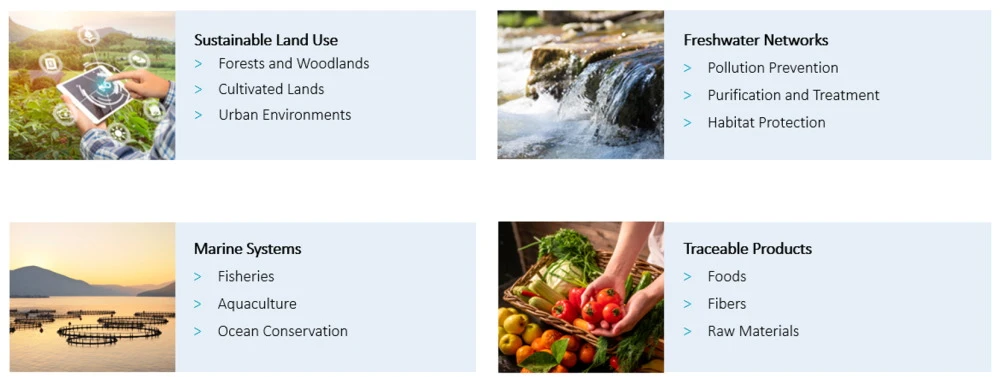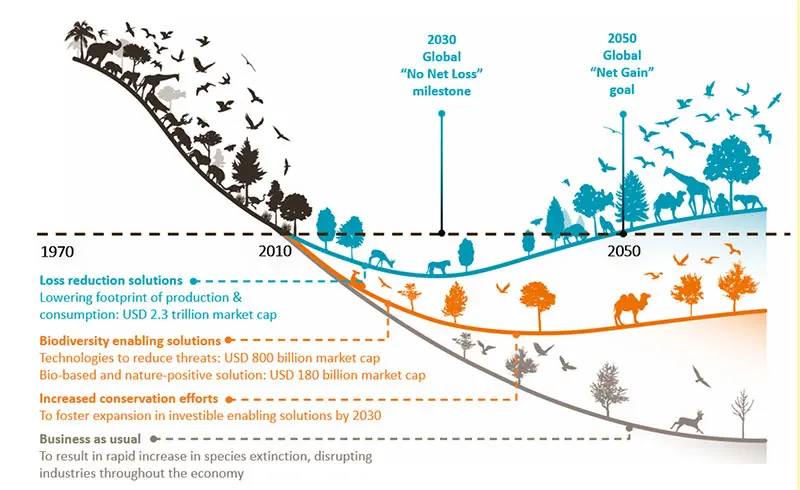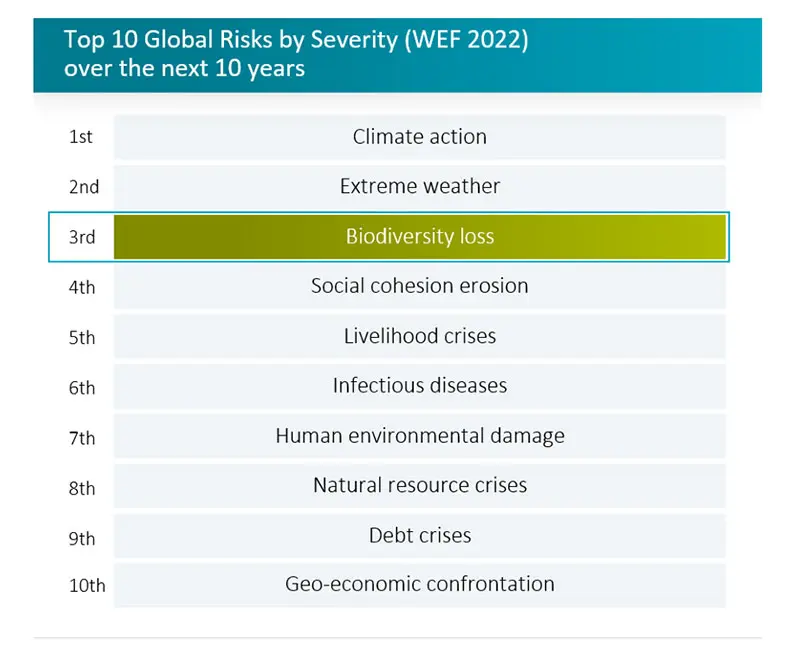RobecoSAM Biodiversity Equities strategy is the culmination of over a year of work to create a product that specifically promotes biodiversity in a targeted thematic style, rather than just investing in environmental or climate-related stocks generally.
The strategy will invest in companies that support the more sustainable use of natural resources and ecosystem services, as well as the technologies, products and services that help to reduce biodiversity threats or restore natural habitats. These are the companies that benefit most from the transition to a nature-positive world that protects biodiversity in all its forms.
“Nearly all human activity in a modern society creates losses; our job is to invest in companies that can profit from being competitively positioned to reduce biodiversity loss,” says David Thomas, Portfolio Manager for the new strategy, which will be launched on 31 October 2022.
“To find those future market winners, we will focus early on sustainable activities that can be found in agriculture, forestry, fishing and ocean-based aquaculture, which represent nearly three-quarters of species loss. Using a system of carefully designed, biodiversity-specific key performance indicators, we can isolate those companies that are meaningfully contributing to the promoting biodiversity.”
The strategy will target a thematic universe of about 250 companies that will be narrowed down to about 40-80 arranged in four investment clusters: Sustainable Land Use; Freshwater Networks; Marine Systems; and Traceable Products. This is shown in the illustration below.

These will target a broad remit of themes, including environmental remediation, reforestation, waste water treatment, hazardous waste management, aquaculture and sustainable fishing. The traceable products theme will look for opportunities in organic food and beverages, eco-friendly furniture and more environmentally friendly consumer goods such as cosmetics.
The strategy will be managed by Robeco’s Zurich-based thematic team which as over 20 years of investment experience running more than EUR 12 billion in impact investing-related assets. The team aims to have about 25% of the portfolio names under engagement to try to further improve the contributions they can make to biodiversity.
Creating the product follows the publication in January 2022 of a positioning paper entitled ‘Robeco’s approach to biodiversity: Towards the integration of nature-related risks, opportunities and impacts in our investments’. The white paper formed a blueprint for future policy and acted as the bedrock for what became Biodiversity Equities.
A science and an art
“Systematically identifying thematically aligned companies with great performance potential is both a science and an art,” says Aaron Re’em, co-Portfolio Manager of the strategy. “But all analysis is underpinned by the same rigor that we’ve applied over more than two decades of developing thematic investment products that target solutions to sustainability challenges.”
“We use our foresight to recognize the structural trends related to biodiversity, apply our proven thematic process to build an investment universe, and select attractively priced winners that are well positioned to benefit from the rapidly evolving competitive landscape.”
These kinds of solutions can be seen in ‘bending the curve’ to stop the decline of biodiversity loss and start reaping both the natural and economic rewards that come from enhancing biodiversity instead, as seen in the graphic below.
Investible solutions arising from bending the curve

Reversing the biodiversity threat by ‘bending the curve’ of biodiversity loss brings huge investment opportunities. Source: Robeco, Bloomberg. Illustration adapted from Leclère et al, Nature, 2020
However, investors have a big job ahead of them in bending this curve. The daily destruction of forests, plants and the natural habitats of animals due to human activity is seen as a challenge as great as the one the world faces with climate change. Unsustainable human development is putting up to one million species at risk of extinction within a few decades.
Climate change is further exacerbating the problem, as older forests and peatlands absorb carbon dioxide, which means deforestation and loss of plant life makes global warming worse. Many scientists believe that climate change and biodiversity loss are two sides of the same coin.
時刻把握我們最新市場觀點及電子報
接收荷寶電子報,率先閱讀最新洞察分析,並構建最綠色的投資組合。
Irreversible consequences
“Biodiversity is an acute threat with irreversible consequences playing out in the here and now,” Thomas says. “Irresponsible development is clearing natural forests, wiping out animal habitats, burning plant species, pumping fish with antibiotics, and dumping chemical fertilizers into waterways on a daily basis. These activities are destructive in real time, not strung out over decades.”
“There is some hope though. Countries have set new national biodiversity targets for 2030, much sooner than the net zero targets of 2050. The EU is leading the way extending mandates on organic farming, increasing quality standards for waterways and soils and legislating measures that support sustainable fishing and aquaculture management. It is also developing a Taxonomy to define what types of investments actually address biodiversity loss.”
SDG alignment
The strategy will invest in companies that can make a contribution to the UN’s Sustainable Development Goals, specifically SDG 3 (good health and well-being); SDG 9 (industry, innovation and infrastructure); SDG 12 (responsible consumption and production)l SDG 14 (life below water); and SDG 15 (life on land).
Within the four clusters, some sectors will naturally produce more portfolio candidates than others, with Consumer Staples generating about one-third of companies, and Industrials one-quarter. Regionally, Europe and the Americas will provide about 40% each.
A vast problem and opportunity
As with climate change, the sums of money involved in avoiding disaster are vast. The World Economic Forum (WEF) estimates that more than half of the world’s economic output of USD 44 trillion is moderately or highly dependent on nature in some form, meaning that if natural systems collapse, so will our economic and financial systems.
The WEF places biodiversity loss as third on its lists of global risks by the perception of their severity, behind climate change and extreme weather. This placed it higher than infectious diseases – despite the recent memory of the ravages of Covid-19 – and the kind of geo-economic confrontation seen when Russia invaded Ukraine.

免責聲明
本文由荷宝海外投资基金管理(上海)有限公司(“荷宝上海”)编制, 本文内容仅供参考, 并不构成荷宝上海对任何人的购买或出售任何产品的建议、专业意见、要约、招揽或邀请。本文不应被视为对购买或出售任何投资产品的推荐或采用任何投资策略的建议。本文中的任何内容不得被视为有关法律、税务或投资方面的咨询, 也不表示任何投资或策略适合您的个人情况, 或以其他方式构成对您个人的推荐。 本文中所包含的信息和/或分析系根据荷宝上海所认为的可信渠道而获得的信息准备而成。荷宝上海不就其准确性、正确性、实用性或完整性作出任何陈述, 也不对因使用本文中的信息和/或分析而造成的损失承担任何责任。荷宝上海或其他任何关联机构及其董事、高级管理人员、员工均不对任何人因其依据本文所含信息而造成的任何直接或间接的损失或损害或任何其他后果承担责任或义务。 本文包含一些有关于未来业务、目标、管理纪律或其他方面的前瞻性陈述与预测, 这些陈述含有假设、风险和不确定性, 且是建立在截止到本文编写之日已有的信息之上。基于此, 我们不能保证这些前瞻性情况都会发生, 实际情况可能会与本文中的陈述具有一定的差别。我们不能保证本文中的统计信息在任何特定条件下都是准确、适当和完整的, 亦不能保证这些统计信息以及据以得出这些信息的假设能够反映荷宝上海可能遇到的市场条件或未来表现。本文中的信息是基于当前的市场情况, 这很有可能因随后的市场事件或其他原因而发生变化, 本文内容可能因此未反映最新情况,荷宝上海不负责更新本文, 或对本文中不准确或遗漏之信息进行纠正。

